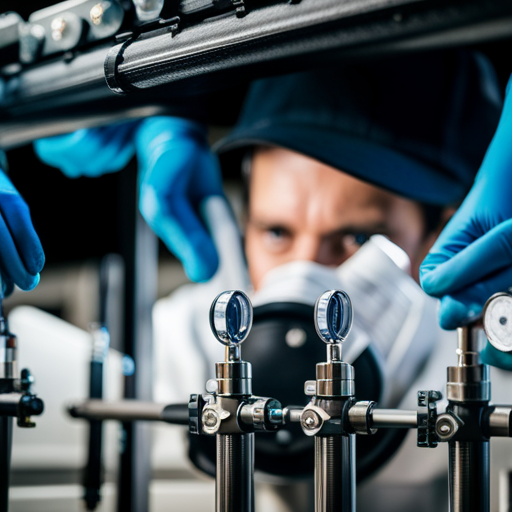Are you experiencing issues with your reverse osmosis (RO) system? Don’t worry, we’ve got you covered.
In this article, we’ll provide you with a comprehensive guide to fixing common RO problems. Whether you’re dealing with a leaky system, low water pressure, or poor water quality, we’ve got the solutions you need to get your RO system back up and running smoothly.
Regular maintenance is important to prevent RO problems from arising, but sometimes malfunctions can occur despite your best efforts. The key to fixing any RO problem is identifying the issue and following the corresponding steps to solve it.
By following our troubleshooting tips, you can address a range of RO problems and ensure that your system is functioning at its best.
So, let’s get started and get your RO system back on track!
Key Takeaways
– Regular maintenance is crucial to prevent RO system malfunctions.
– Identifying the problem is the first step to fixing it.
– Checking valves, filters, and hoses is important for proper system functioning.
– Regular filter replacement can prevent clogs and damage to plumbing.
Common RO Problems
If you’re experiencing issues with your RO system, you may be facing common problems such as low water pressure, slow water flow, bad taste or odor, leaking membrane housing, gurgling noises, leaking filters or faucet, cloudy water, continual running, clogged air gap or drain saddle, or a leaking water storage tank.
These problems can be caused by a variety of factors such as clogged filters, damaged system components, or incorrect pressure settings. Regular filter replacement and maintenance can prevent clogs and damage to plumbing, while checking valves and other system components is important for proper system functioning.
One of the most common solutions for RO problems is regular filter replacement. Sediment and carbon filters should be replaced regularly to prevent clogs and bad taste or odor. Adding a UV filter can also remove bacteria and other contaminants from the water.
Troubleshooting requires a basic understanding of system components and the corresponding steps to take for each problem. Identifying the issue is the first step to fixing it, and regular maintenance is necessary to ensure proper system functioning.
Solutions
To solve common issues with your reverse osmosis system, try checking valves, filters, and hoses, adjusting pressure, replacing membranes, filters, and faucets, purging air from the system, regularly replacing filters, adding a UV filter, and promptly identifying and repairing leaks.
If you’re experiencing slow water flow, try replacing the membranes, filters, and faucets. Additionally, purging air from the system can help improve water flow.
If you notice bad taste or odor in your water, regularly replacing the sediment and carbon filters can help. Adding a UV filter can also remove bacteria and other contaminants, which can improve the taste and quality of your water.
If you’re experiencing low water pressure, check the valves, filters, and hoses. Adjusting the pressure can also help improve water flow.
If you notice cloudy or milky water, regularly replacing the filters and adding a UV filter can help.
For continual running, check the tank valve and pressure.
Troubleshooting your reverse osmosis system requires a basic understanding of its components. Regular maintenance, such as replacing filters and identifying and repairing leaks, is necessary to ensure proper system functioning.
Importance of Maintenance
Regular maintenance is crucial to ensure that your reverse osmosis system functions properly and provides clean and safe drinking water. By regularly checking and maintaining your RO system, you can prevent malfunctions and breakdowns, prolong the lifespan of the system, and reduce repair costs.
In addition, regular maintenance is essential for ensuring water quality and safety. Checking valves and filters, replacing membranes and filters, and adding a UV filter can all help to prevent clogs, remove bacteria and other contaminants, and identify potential problems early.
By taking the time to maintain your RO system, you can ensure that you and your family have access to clean and safe drinking water.
Conclusion
Congratulations! You’ve successfully troubleshooted your RO system with the help of this comprehensive guide. By following the steps outlined, you’ve solved various common problems and ensured that your system is functioning properly.
However, it’s important to note that regular maintenance is key to preventing future issues from arising. Make sure to schedule routine maintenance checks and follow the manufacturer’s guidelines for cleaning and replacing filters.
By taking good care of your RO system, you can enjoy clean and safe drinking water for years to come. Remember, prevention’s always better than cure!
